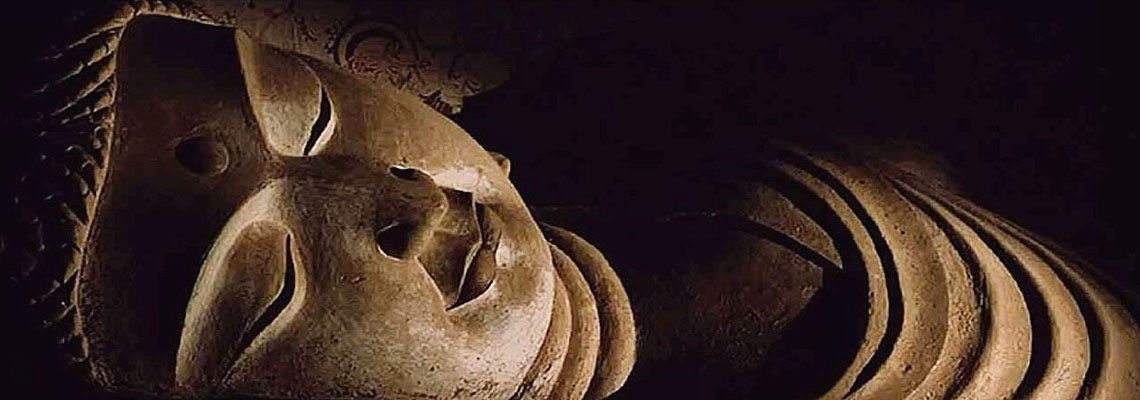
Day 1
BeijingPlease arrange for the international flight to get to Beijing. We will meet you at the Beijing airport, transfer you to the hotel and check you in. The rest of the day will be your free time to do a little exploration.
Day 2
Beijing-
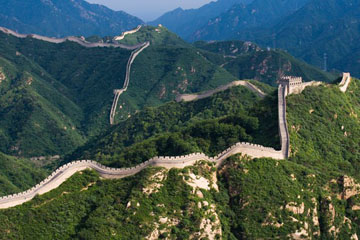
- The Great Wall
Today we will visit the famous Great Wall, Ming Tomb, The Forbidden City, and the Temple of Heaven.
The Great Wall: This is one of the seven wonders of the world and the symbol of China. Badaling Great Wall, located 80km north-west of Beijing, is the most impressive and the most visited section of the Great Wall of China. Constructed in 1502 during the Ming Dynasty, the Badaling Great Wall once served as an important military fortification. Many leaders from China and around the world, like Richard Nixon, Margaret Thatcher, had all visited this section of the wall.
The Ming Tombs: Also known as the “13 Tombs”, this is a collection of mausoleums of the 13 out of 17 of the Ming Dynasty emperors. The tomb that can be visited is that of Emperor Wanli, who reigned from 1537 to 1620, and his two empresses. Unearthed in 1956, this is literally an underground palace located 27m below ground surface.
The Forbidden City: Located at the city center and called Gu Gong in Chinese, it was the imperial palace for twenty-four emperors during the Ming and Qing dynasties. It took 14 years to build during the reign of Emperor Chengzu in the Ming Dynasty (1368-1644). Ancient Chinese Astronomers believed that the Purple Star (Polaris) was in the center of heaven and the Heavenly Emperor lived in the Purple Palace. The Palace for the emperor on earth was so called the Purple City. It was forbidden to enter without special permission of the Emperor. Hence its name 'The Purple Forbidden City', usually just 'The Forbidden City’. Also called Palace Museum, the Forbidden City is recognized as the most magnificent and splendid palace complex in China and one of the five world-famous palaces, along with the Palace of Versailles in France, Buckingham Palace in England, the White House in United States, and the Kremlin in Russia.
The Temple of Heaven: Temple of Heaven, or Tiantan, is located in the southern part of Beijing, and has been one of the most sacred places for the whole country for more than five centuries. The complex was visited by the Emperors of the Ming and Qing dynasties for annual ceremonies of prayer to heaven, and is the largest one in Beijing among several royal altars to Heaven, Earth, Sun, Moon and other deities or symbolic forces of Nature.
Day 3
Beijing-

- Panda Reserve
After breakfast you will be transferred to the airport to take the flight to Chengdu. After checking into the hotel in Chengdu, we will visit the Panda Reserve and then take the city tour.
Panda Reserve: This is the Giant Panda Breeding and Research Centre - Zoos, scientific research centers, breeding centers, or semi-protected areas work together to maintain a self-sustaining population of a given species. This population may serve as a hedge against extinction of the species, as well as a reservoir for improved understanding of its natural history. The Chengdu Panda Base is an example of a scientific institute engaged in research towards conservation. The goal is not only to provide technical support for scientific research on wild pandas, but also to increase the wild population through improved management and, ultimately reintroduction of individuals into areas from which the populations have declined. Research at the Chengdu Panda Base focuses on the advancement of wildlife conservation in China.
Day 4
Chengdu-
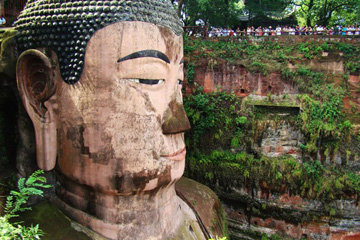
- Leshan Giant Buddha
After breakfast we will head to Leshan to visit the Leshan Giant Buddha.
Leshan Buddha Sculpture: The Giant Buddha (Dafo in Chinese) of Leshan is the tallest stone Buddha statue in the world, carved out of a cliff face by an 8th-century monk in southern Szechuan province. The Giant Buddha overlooks the confluence of the Minjiang, Dadu and Qingyi rivers and faces the sacred Mount Emei (with which it shares its World Heritage status). Construction on the Giant Buddha began in 713 AD. It was the idea of a Chinese monk named Haitong, who hoped that the Buddha would calm the turbulent waters that plagued the shipping vessels traveling down the river. His plans were not just supernatural, as it turned out. What had happened was that the enormous amount of rubble carved away from the cliff would be deposited in the river, actually altering the currents and calming the waters.
Day 5
Chengdu-
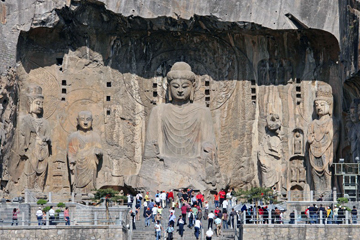
- Longmen Grottoes
In the early morning you will take the flight to Xi'an. Then you will head to Luoyang by bus. After checking into the hotel, we will visit the Longmen Grottoes.
The Longmen Grottoes: Located near Luoyang, Henan Province, the Longmen Grottoes are a treasure house of ancient Buddhist cave art. Live cultural relics lie amid green mountains and serpentine rivers. In 2000, it was enlisted into the List of World Heritage. The grottos were hewed and carved during the Northern Wei Dynasty (386-534), when the rulers relocated their capital at Luoyang near the end of the 5th century. At that time Buddhism was spreading east into China and was venerated by the imperial court. The Buddhists adopted the practice of carving rock temples, dedicated to the Buddha.
Day 6
Luoyang-

- The Tang Dynasty Show
After breakfast you will take the flight to Xi'an. After checking into the hotel in Xian, we will visit the Shaanxi Museum. In the evening, we will enjoy the Tang Dynasty Show.
Shaanxi History Museum: This provincial museum is one of the major museums in China. It holds numerous unearthed cultural artifacts from within the Shaanxi province as well as the rest of China. It covers 65,000 square meters, with a building area of 60,000 square meters. The newly built modern building recreates Tang-dynasty architecture and successfully symbolizes the great extent of Shaanxi history and its remarkable culture.
The Tang Dynasty show: This is the show that presents the palace dances and songs from the Tang Dynasty (618AD-907AD) when Xian was the capital of China.
Day 7
Xi'an-

- The Terra-cotta Warriors and Horses
In the morning we will head to the Terra-cotta Warriors and Horses. After that you will have free time to take the city tour.
The Terra-cotta Warriors and Horses: This is one of the greatest archaeological findings of the 20th century - the army of terra-cotta warriors and the bronze chariots entombed in vast underground vaults at emperor Qin Shi Huang's tomb from two thousand years ago. It is a sight not to be missed by any visitor to China. Emperor Qin Shi Huang ascended to the throne of Qin at the age of 13 in 246 BC. Under him, Qin conquered the other six warring states and became the first true emperor, or Shi Huang, of China.
Day 8
Xi'an-
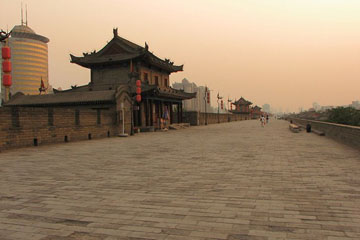
- The Ancient City Wall
After breakfast we will visit the City Wall and The Grand Mosque. Then you will take the train to Lanzhou.
The Ancient City Wall: This is the most complete city wall that has survived in China as well being one of the largest ancient military defensive systems in the world. It was enlarged in Ming Dynasty (1368-1644) from the city wall initially built in Tang Dynasty (618 -907). Now it is 12 meters tall, 12-14 meters wide covering 14 kilometers in length with a deep moat surrounding it. The City Wall has corner towers, ramparts, sentry towers, gate towers, battlements and a number of city defensive fortifications with very strong defense capability. You can walk, even cycle on the wall. Its south gate is the largest with a suspension bridge. Most of the tourists choose the south gate for sightseeing.
Grand Mosque (and Old Muslim Quarter): The Grand Mosque is a Chinese traditional Alhambresque architecture with a long history and grand scale, and is a great combination of Islamic and Chinese culture. It was recorded that it was established in the first year of the Tian Bao reign by the Tang Dynasty Emperor Li Lung Ji (685AD-762AD). After renovations and expansions on several occasions in the Song, Yuan and especially the Ming and Qing Dynasties, it gradually took on the current appearance. The whole mosque has more than 12,000 square meters, the floor space more than 4,000 square meters. The construction is mostly in the Ming Dynasty style. The Mosque therefore has much Chinese traditional touch in both its design and artistic outlook. Besides the style peculiar to Islamic mosques, this Mosque also holds characteristics of Chinese pavilions with painted beams and engraved ridgepoles. The Grand Mosque and the Muslim Quarter are now an important cultural preservation of Shanxi Province and a national-level historical/cultural preservation site.
Day 9
Lanzhou-
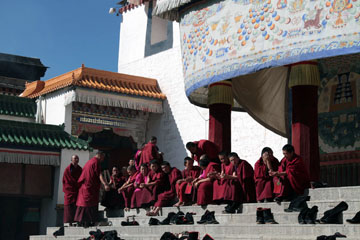
- Labrang Monastery
We will visit the Gansu Provincial Museum in Lanzhou, and then head to Xiahe. After arriving in Xiahe we will check into the hotel.
Gansu Provincial Museum: Located in Lanzhou City, the Gansu Provincial Museum is the biggest comprehensive museum in the province. It is one of the best sights in the city and a visit is well worthwhile. Built in 1956, the museum covers a total area of 18,000 square meters (about 4 acres). Designed by the soviet experts, this museum provides visitors with a unique and memorable experience. The museum is divided into two sections - natural resources and historic exhibits. It houses collections of various color-painted potteries of Neolithic Age and treasures of ancient grottoes. A 4-meter-tall Mammoth fossil replica is stored in the museum whose remains were excavated from the Yellow River basin in 1973. Aside from the prehistoric presentations, there are also rare animal exhibits, such as pandas, golden monkeys and red -crowned cranes.
Day 10
Labrang Monastery-
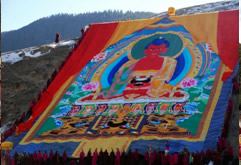
- Sunbathing Budda Festival
After breakfast we will experience the Sunbathing Buddha Festival, which is held on the 13th of January (China Luna calendar). The Sunning of the Buddha is a spectacular sight for any traveler to witness. The morning begins with Cham dancing, performed by monks in splendid robes and hats, some wearing fearsome masks and others with their faces painted in ferocious expressions. The dances are slow and grotesque, accompanied by doleful brass horns, cymbals and drums, and are intended to dispel all evil spirits. After hours of dancing, praying and chanting of scriptures, a 30m by 20m roll of multi-colored applique and embroidered thangka is proudly and reverently paraded through the streets from the monastery to the hillside across the river. All along the route, faithful Buddhists scramble to press their foreheads and hands against this sacred image, while mounted riders laughingly clear the way by snapping their whips as their spirited horses rear and snort. As the procession reaches the bridge that crosses the Daxia River, thousands scatter to find the most perfect vantage point for the sunning ceremony.
Day 11
Xiahe-
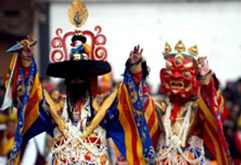
- Masked Dancing
After breakfast we will enjoy the Masked Dancing, before we head to Jiayuguan by bus.
As crowds gather in the largest square of the monastery, laymen use long canes to playfully tap the encroaching throng, reminding them that space must be made for the upcoming festivities. A huge striped tiger, strangely the size of two men, running around the square and amongst the crowd ensures that the people are entertained, while maintaining an area sufficient for the dancing that will follow. Meanwhile other monks are preparing their costumes, masks, and musical instruments to ensure a consummate performance before the Living Buddha of Labrang. Finally, the entourage appears as horns and trumpets bellow greetings; dancing and music ensue to ward off evil spirits and ensure prosperity in the New Year.
Day 12
Jiayuguan-
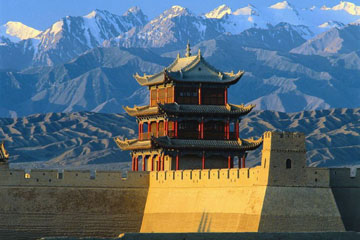
- The Jiayuguan Pass
We will visit the Jiayuguan Pass, The Great Wall on the Cliff, Great Walls Museum. After that we will head to Dunhuang.
Jiayuguan Pass: Jiayuguan Pass stands in the southwest part of Jiayuguan City, about 6 km away from downtown. The Ming Dynasty fort here guards the strategic pass, at the western end of the Great Wall – this was the last section built by the Ming Dynasty. Construction of the fort was started in 1372 in the Ming Dynasty, and subsequently enlarged and strengthened, and was known as 'the strongest pass under heaven'. It is located in the Jiayu Highland, hence its name Jiayuguan. It is situated between the Wenshu and Heishan Mountains at the foot of Jiayuguan Hill of the Qilian Mountain range.
The Great Wall on the Cliff: The Suspended Wall is a part of the Great Wall of China. The wall here was built on the ridge with a gradient of 45 degrees. It is high in the air and it looks as if it fell down from the top of the hill. So people refer to this section of the Great Wall as the "Suspended Wall". The Suspended Wall, the extension of the walls at the Jiayuguan Pass towards the north, was an integral part of the ancient defense system at the Jiayuguan Pass.
Great Wall Museum: The Great Wall museum opened to visitors in October 1989, and it is the first museum to exhibit the Great Wall culture in a comprehensive and systematic way. The Museum covers an area of 12,312 square meters with an exhibition area of about 1,766 square meters. Its main building takes a shape of a typical signal fire tower on the Great Wall.
Day 13
Dunhuang-
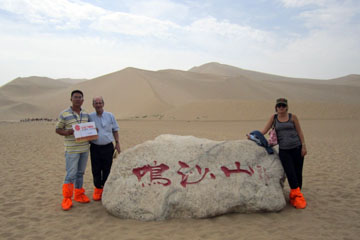
- Echoing Sand Mountain
We will visit the famous Mogao Grottoes, Echoing-Sand Mountain and Crescent Lake. After that we will transfer you to the train station to take the train to Turpan.
Mogao Grottoes: The Mogao Grottoes, a shrine of Buddhist art treasures, is 25 km from downtown Dunhuang on the eastern slope of Mingsha Shan (Echoing Sand Mountain). A network of plank-reinforced roads plying north to south 1600 meters long lead to the cave openings, which are stacked five stories high, some reaching up to 50 meters. Incidentally, Mogao means high up in the desert. According to Tang Dynasty records, a monk had witnessed onsite a vision of thousand Buddhas under showers of golden rays. Thus inspired, he started the caves construction work that spanned a millennium, from the 4th to the 14th centuries. What remains today is truly awe inspiring, and is likely the world’s richest treasure house of Buddhist sutras, murals and sculptures. Please note that cameras are not allowed inside the grottoes.
Echoing-Sand Mountain and Crescent Lake: Together with the Crescent Spring and the Mogao Caves, the Echoing-Sand Mountain is the most popular tourist site in Dunhuang. Echoing-Sand Mountain, known as Mingsha Mountain to the Chinese, is 5 km to the south of Dunhuang and is famous for the constant sound of the moving sand. Legend has it that many years ago a horrific battle was fought here, and the sounds we hear today were the haunting cries of soldiers buried in the sand dunes. Situated within the Echoing-Sand Mountain Park, the Crescent Moon Lake is literally an oasis in the desert. The lake’s name derives from the crescent moon shape taken by the pool of spring water between two large sand dunes. Although the surrounding area is very dry, the pool surprisingly doesn’t dry up as one might expect.
Day 14
Turpan-
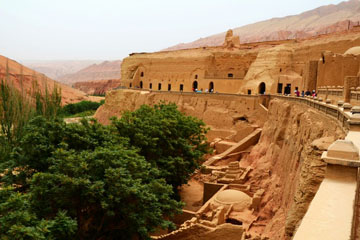
- Bezklik Grottoes
We will check you into the hotel after your arrival in Turpan. After that we will visit the Bezklik Grottoes, Astana Tombs, and Tuyoq Valley.
Bezeklik Grottoes: The Bezeklik Grottoes, or Thousand Buddha Caves, is a complex of Buddhist cave grottos dating from the 5th to 14th century between the cities of Turpan and Shanshan at the north-east of the Taklamakan Desert near the ancient ruins of Gaochang in the Mutou Valley. They are high on the cliffs of the west Mutou Valley under the Flaming Mountains, and most of the surviving caves date from the West Uyghur kingdom around the 10th to 13th centuries. There are 77 rock-cut caves at the site. Most have rectangular spaces with rounded arch ceilings often divided into four sections, each with a mural of the Buddha. The effect is of entire ceiling covers with hundreds of Buddha murals. Some murals show a large Buddha surrounded by other figures, including Turks, Indians and Europeans. Some of the murals are masterpieces of religious art.
Astana Tombs: This is the graveyard of the residents who lived in the Gaochang City in the Jin-Tang period. Between 1959 and 1975, a great number of cultural relics had been unearthed, including Chinese documents, textiles, epitaphs, coins, clay sculptures, pottery, wooden wares, silk-paintings, crops and foods, etc. The site is known as the Underground Museum.
Tuyoq Valley: This is a 12 km long primitive Uighur agricultural valley about 70 km from Turpan, with vineyards and fields in the northern and southern valleys and a narrow ravine that connects them. It is a Muslim religious pilgrimage site. The southern mouth of the valley has big Uighur mosques older than the Sugong Minaret and a cave thought by many to be described in the Koran. About a kilometer from the cave shrine is a group of grottoes that have some Buddhist and Nestorian artwork. These grottoes are said to date from the West Jin Dynasty (265AD-316AD), and are considered to be the earliest in Turpan. Most of the murals are damaged. Fortunately, 10 of the grottoes still have some of the preserved murals. These precious murals are very unique in style.
Day 15
Turpan-
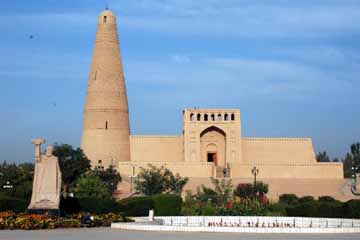
- Sugong Minerat
In the morning we will visit the Jiaohe Ruins, Karez Irrigation system, Sugong Minaret, then head to Urumqi by bus.
Jiaohe Ancient City Ruins: The city's name means 'River City'. It was founded during the first century BC and abandoned during the 15th century. It is located atop a steep cliff on a leaf-shaped plateau between two deep river valleys in the Yarnaz valley 10 km to the west of Turpan City. It runs northwest to southeast, 1760 meters long and 300 meters across at the widest part. The ruins include city gates, streets and lanes, government office, temples, domestic houses, cave houses, wells, and an underground temple. It is part of the UNESCO World Heritage Silk Road Sites.
Karez Irrigation System: The ancient Karez Irrigation System, which is still used today, is a unique irrigation system in Turpan. It takes advantage of the slopes, draws the underground water to flow by itself to irrigate farmland. It consists of four parts: vertical wells, underground channels, ground canals, and small reservoirs.
Sugong Minaret: Located in Mura Village 2km to the east of the city of Turpan, the minaret tower was built in the 41st year of the long reign of Qianlong Emperor during the Qing Dynasty. It is the embodiment of the ancient architectural arts of the Uighur people. The body of the tower is cylindroid in shape, built with bricks arranged in various symmetrical patterns on the outer wall. The tower has 14 windows and a spiral staircase inside going to the top.
Day 16
Urumqi-
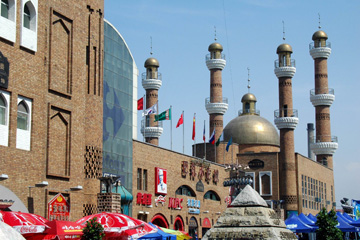
- International Bazaar
After breakfast we will visit the Xinjiang Museum, Erdaoqiao Market & International Bazaar.
Xinjiang Museum: The Xinjiang Regional Museum is a large integrated museum and a centre for the collection and study of cultural relics in Xinjiang. The museum was built in 1953, featuring Uighur ethnic internal decor style and has an exhibition hall covering an area of about 7,800 square meters. There are more than 50,000 pieces of various kinds of cultural relics stored in the museum, among them are the ancient mummies represented by the “Loulan Beauty”, manuscripts in Chinese, Karosthi, Qiuci, Yanji, Tibetan, Uighurian and other characters prevailing in ancient western regions of China, as well as silk, wool, cotton and hemp fabrics and folk raiment, etc., all items of great intrigue. The 'Loulan beauty' mummy in particular is a well-preserved mummy from 4000 years ago. It still has a reddish brown skin, thick eyelashes, charming large eyes, and long hair.
Erdaoqiao & International Bazaar: Here you will find a bustling market filled with fruits, clothing, crafts, knives, carpets, and almost anything that you can imagine. This is the largest bazaar in Urumqi, and is a place most welcomed by tourists, especially the ladies who will find they can buy some traditional Yugur cosmetics. On Sunday, there are more stalls and more goods to buy than any other day. The old streets around the bazaar are particularly worth seeing.
Day 17
Urumqi-
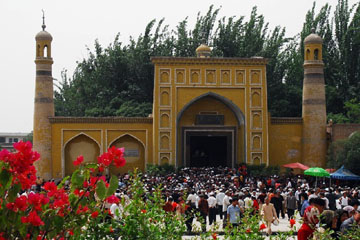
- Id Kah Mosque
In the morning you will take the flight to Kashgar. Upon arrival we will visit the Id Kah Mosque, and Handicraft street.
Id Kah Mosque: This is the largest mosque in China, and the most famous mosque in Xinjiang. The construction of the mosque started in the middle of the 15th century, and the mosque has gradually developed to its present size. The buildings of Id Kah Mosque look magnificent and solemn, and display the artistic styles of Islamic mosque architecture. The Mosque has an area of about 16,800 square meters, consisting of the Pray Hall, the Koran teaching Hall, the Corridor, the Arches and other buildings attaching to it. The Pray Hall of the mosque, which can hold 4,000 prayers, is supported by 140 carved wooden pillars.
Handicraft Street: Handicraft Street, or Zhiren Street, is a fascinating place showing the distinctive custom and culture of Kashgar, with many full-time handicraftsmen working on the street and hundreds of workshops and booths alongside. This street is an exhibition for traditional Kashgar and mid-Asian handicrafts. Copper, metal, porcelain, woodwork, jewellery and other goods are seen to be made here and you will marvel at the incredible devices like the wooden objects that prevent babies from wetting the bed.
Day 18
Kashgar-
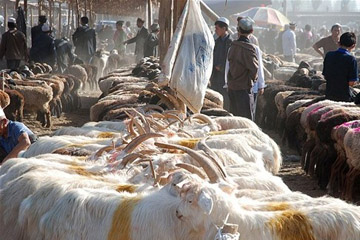
- Sunday Bazaar
Today we will visit the Sunday Bazaar, Apak Hoja Tomb, and Old town.
Sunday Bazaar: This is called “Sunday” bazaar but it is open daily, even though it is busiest on Sundays. Streets near this big market are jammed with farmers and buyers arriving by donkey cart, truck, bicycle, horseback, ute, motobike, or on foot, with their animals. It is loud, lively and cheerful as they arrive, eat breakfast, set up their animals and check out the action. Cattle, sheep (they definitely look different), goats, donkeys, horses have their own sections. Sellers show off their animals as “good eaters” (most go as livestock, not meat). The entire experience is fascinating and fun.
Apakh Hoja Tomb: This Mazar is the holiest place in Xinjiang for the Muslims, and an architectural treasure. Built in 1640, it is reminiscent of the Central Asian artistic style of Samarkand or Isfahan. The site is also known as the Xiang Fei (Fragrant Concubine) Tomb in memory of Abakh Khoja's granddaughter, Iparhan, who was the Fragrant Concubine of Emperor Qianlong of Qing Dynasty. A handsome blue-and-white tiled gate leads into the compound, which includes a small religious school and the Abakh Khoja family tomb. The latter is domed and faced with muti-color tiles. It is the most complete Islamic tomb dating from the beginning of the Qing Dynasty.
Old Town: Kashgar is an ancient city, and in walking the streets of its Old Town, one gets the sense of what this legendary Central Asian hub was like in the days when the Silk Road was at its zenith. 500-year old remnants of the city wall, narrow lanes and colorful multi-ethnic crowds combine to make Kashgar’s historic district a highlight of any visit to the city. Visit the small alleys to look at the characteristic Uygur residences. You will experience and enjoy the culture and history that has been retained in the small alleys and deep courtyards. In the alleys on platforms beside the residence you could marvel at the even more ancient primitive workshops for hand-made earthenware. Some 17 or 18 antique workshops have been restored.
Day 19
KashgarAfter breakfast we will check out of the hotel. We will transfer you to the airport to take the flight to your destination.
| Travel in party of |
Superior Class ★★★★★ |
Deluxe Class ★★★★ |
Tourist Class ★★★ |
| 2-5 persons | N | $ | $ |
| 6-9 persons | N | $ | $ |
| 10 persons & above | N | $ | $ |
| Single room Supplement | N | $ | $ |
Service included:
√ Meals as listed in the itinerary, B=breakfast; L=lunch ;
√ Personal Guide & Driver + Private car / van for Private Transfers & sightseeing
√ Hotels with breakfast(twin share bases) as listed in the itinerary .
√ Domestic flights or trains as listed in the itinerary Beijing to Chengdu,. Chengdu to Xi'an, Urumqi to Kashgar
√ Airport Taxes: US$30for domestic,
√ Service Charge & Government Taxes .
√ Luggage Transfers between airports and hotels
√ Goverment letter for visa support
Service excluded:
* Personal expenses, tips to the guide and driver.
* Domestic Flight from Kashgar to your destination

